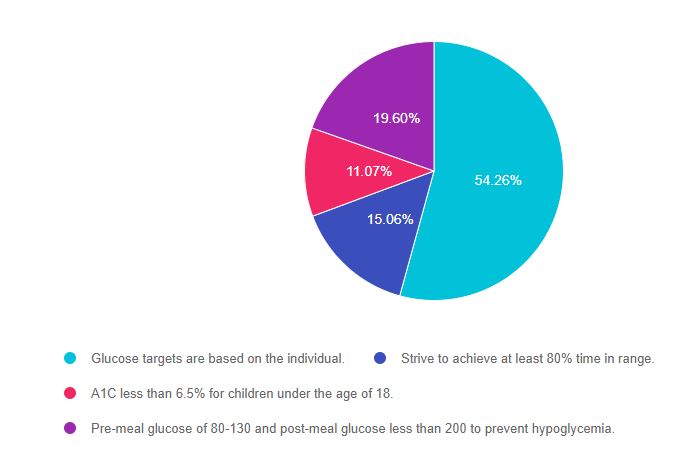
For our June 15th Question of the Week, only 54% of respondents chose the best answer. We want to “take a closer look” at this question with the aim for 100% correct responses the next to go around.
Before we start though, if you don’t want any spoilers and haven’t tried the question yet, you can answer below: Answer Question
Question: RT is 12 years old and has a new diagnosis of type 1 diabetes.
Based on the ADA Standards of Care, what is the most accurate statement regarding glycemic goals?
Answer Choices:
- Glucose targets are based on the individual.
- Strive to achieve at least 80% time in range.
- A1C less than 6.5% for children under the age of 18.
- Pre-meal glucose of 80-130 and post-meal glucose less than 200 to prevent hypoglycemia.

As shown above, the most common choice was option 1, the second most common answer was option 4, then option 2, and finally option 3.
Getting to the Best Answer
If you are thinking about taking the certification exam, the content of this practice test question will set you up for success. The exam will present questions that require test takers to be familiar with the goals of care for specialty populations, including pediatrics.
Answers & Rationale
Answer 1 is Correct, 54.26% chose this answer, “Glucose targets are based on the individual.” GREAT JOB. This is the best answer. The American Diabetes Association provides a general A1c target of 7% or less for pediatrics, but it encourages the person with diabetes and the care provider to determine glucose ranges that best match the individual based on their values, preferences, access to technology and safety.
Answer 2 is incorrect, 15.06% of you chose this answer, “Strive to achieve at least 80% time in range.” According the the ADA, the time in range target is 60% or an A1c of less than 7.5% for those under the age of 25. Of course, these goals are customized to match the individual.
Answer 3 is incorrect, 11.07% of you chose this answer, “A1C less than 6.5% for children under the age of 18..” This is a juicy answer. This target may be right for those who are using a CGM, pump and advanced technology features that help users avoid hypoglycemic events. But this is not the A1C target for all children with type 1 diabetes, so this is not the best answer. There is no A1C target that fits all.
Answer 4 is incorrect, 19.60% of you chose this answer, “Pre-meal glucose of 80-130 and post-meal glucose less than 200 to prevent hypoglycemia.” The American Diabetes Association provides a general A1c target of 7% or less for pediatrics, but it encourages the person with diabetes and the care provider to determine pre and post meal glucose ranges that best match the individual based on their values, preferences, access to technology and safety.
We hope you appreciate this week’s rationale! Thank you so much for taking the time to answer our Question of the Week and participate in this fun learning activity!
Want to learn more about this topic? Enroll in our
Level 2 | From Tots to Teens Diabetes Standards | 1.5 CEs

This course includes updated goals and guidelines for children living with type 1 or type 2 diabetes. This course discusses the special issues diabetes educators need to be aware of when working with children with diabetes and their families.
We discuss the clinical presentation of diabetes, goals of care, and normal growth and development through the early years through adolescence. Strategies to prevent acute and long term complications are included with an emphasis on positive coping for family and child with diabetes.
Topics include:
- Discuss the goals of care for Type 1 and Type 2 Kids with Diabetes
- State Strategies to prevent acute and chronic complications
- Discuss the importance of positive psychosocial adjustment and resources
See Full Calendar for upcoming webinars and Virtual Courses.
Can’t make it live? All paid registrants are guaranteed access to the video presentation, handouts and podcasts.
Sign up for Diabetes Blog Bytes – we post one daily Blog Byte from Monday to Friday. And of course, Tuesday is our Question of the Week. It’s Informative and FREE! Sign up below!
[yikes-mailchimp form=”1″]Accreditation: Diabetes Education Services is an approved provider by the California Board of Registered Nursing, Provider 12640, and Commission on Dietetic Registration (CDR), Provider DI002. Since these programs are approved by the CDR it satisfies the CE requirements for the CDCES regardless of your profession.*
The use of DES products does not guarantee the successful passage of the CDCES exam. CBDCE does not endorse any preparatory or review materials for the CDCES exam, except for those published by CBDCE.









